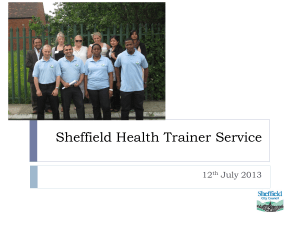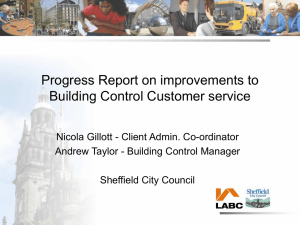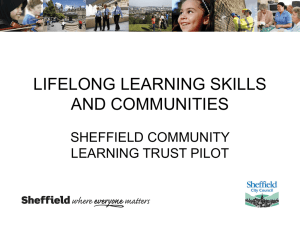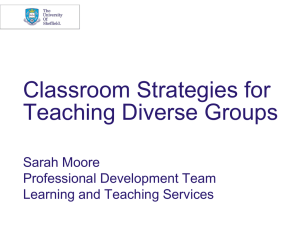Action research - Methodological Challenges
advertisement
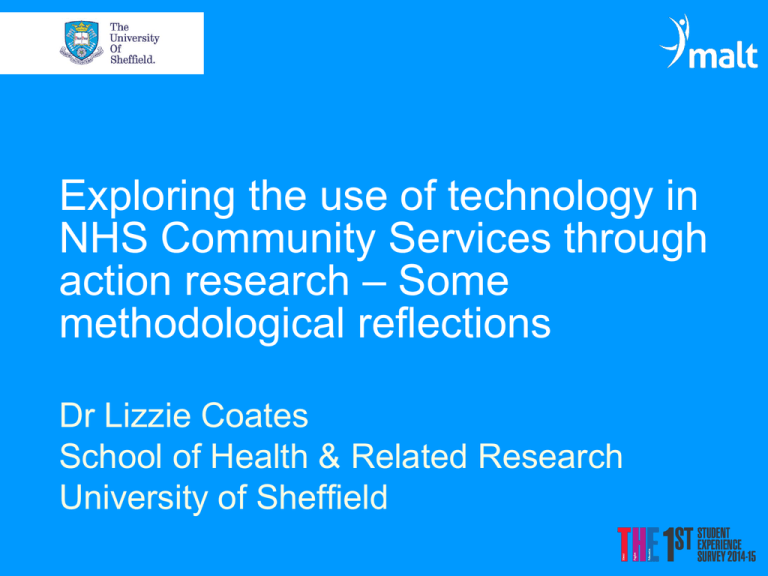
Exploring the use of technology in NHS Community Services through action research – Some methodological reflections Dr Lizzie Coates School of Health & Related Research University of Sheffield Today’s seminar • Background to the research • Outline of methodology • Methodological reflections • Preliminary conclusions 13/04/2015 © The University of Sheffield Background to the research What is telehealth? ‘Telehealth … refers to services that use various point-of-care technologies to monitor a patient’s physiological status and health conditions’ NHS England (2014) •Multiple conceptual and operational definitions (Fatehi and Wootton 2012) •Remote monitoring of patients at home 13/04/2015 © The University of Sheffield STEP 1 Patient provides and uploads monitoring data STEP 2 Patient data is checked and patients who alert are triaged STEP 3 Patients requiring follow-up are contacted by a clinician 13/04/2015 © The University of Sheffield Rationale for the MALT study • Uptake and expansion of telehealth not developed at pace and scale anticipated • MALT study commissioned by the Technology Strategy Board in 2011 to identify, explore and seek to overcome key barriers and facilitators to delivering telehealth at scale: • Financial • Organisational • Operational 13/04/2015 © The University of Sheffield Aims of the MALT study Phase 1: Map and model current services Interview all stakeholders in four health services sites Review current practice Design user acceptance questionnaire Design financial models Phase 2: Implement, evaluate and refine Implement action research projects in sites Test financial models Test user acceptance questionnaire Develop future business models JAN 2012 – SEPT 2013 Phase 3: Disseminate Produce guides and tools to assist health and care providers, commissioners and industry Share findings with patients, carers and wider public APR 2013 – APR 2014 APR 2014 – NOV 2014 13/04/2015 © The University of Sheffield Outline of methodology Methodology – Phase 1 • Four community health settings remotely monitoring patients with COPD and CHF in routine practice • In-depth qualitative case studies of each site: • Explore referral and care pathways • Examine usage and acceptance • Identify barriers and enablers Reported in Taylor et al (under review), Brewster et al (2013) 13/04/2015 © The University of Sheffield Data collection – phase 1 Participants in each site SITE A SITE B SITE C SITE D No. of frontline staff participants 21 17 21 25 No. of managerial staff participants 6 6 7 2 Staff Participant Role No. of participants Community matrons and nurse specialists 49 Other frontline nursing and support staff 25 Clinical leads and service managers 10 Organizational, strategic and commissioning managers 21 Total 13/04/2015 © The University of Sheffield 105 Methodology – Phase 2 • Action research to identify key areas for improvement and implement changes that will help to address them • Work with sites as they implement and evaluate identified changes and improvements to telehealth delivery • Observe and measure change throughout phase 2 where possible, and conduct focus groups 13/04/2015 © The University of Sheffield Methodology – Phase 2 • Action Inquiry Groups set up in each site: • New developments, e.g. new roles, different utilisation • Current barriers, e.g. improvements to existing system • 5/6 groups established in each site – members include frontline staff and managers • 58 participants in total – 4-14 per site per cycle • Ran 2 ‘plan, do, study, act cycles’ over 6 months 13/04/2015 © The University of Sheffield Participants – Phase 2 Participant Role Site A Site B Site C Site D Community Matrons and nurse specialists 8 4 5 4 Other frontline staff and support staff 1 1 7 7 Clinical leads and service managers 5 1 3 5 Organisational, strategic and commissioning managers 0 1 5 0 Patient 0 1 0 0 Total 14 8 20 16 13/04/2015 © The University of Sheffield Total 21 16 14 6 1 58 Methodology – Phase 2 Action research ‘proceeds in a spiral of steps, each of which is composed of a circle of planning, action and factfinding about the result of the action.’ Lewin (1946:38) ‘Action research is the study of a social situation carried out by those involved in that situation in order to improve both their practice and the quality of their understanding.’ Winter and Munn-Giddings (2001: 8) 13/04/2015 © The University of Sheffield Methodological reflections Why consider this now? • Reflexivity as practice, both generally (Mason 2002) and as marker of quality in action research (Bradbury Huang 2010) • Importance of process (and findings) from action research (Winter & Munn-Giddings 2001) • Incongruence between organic telehealth service development and, conduct of robust research, identified as barrier (Hendy et al 2012) 13/04/2015 © The University of Sheffield Emerging issues 1. Access 2. Informed consent 3. Confidentiality and anonymity 4. Power and relationships 5. Role of the research team 6. Validity 13/04/2015 © The University of Sheffield 1. Access • Initial problems with access highlight issues with telehealth adoption writ large • Recruitment and participation • Staff engagement fragile (Taylor et al, under review) • Scale of change currently affecting NHS • Multiple perspectives and diffuse ownership (May et al 2011, Greenhalgh et al 2012) 13/04/2015 © The University of Sheffield 1. Attrition over time Site A M1 M2 M3 Site B 1 2 3 4 5 6 7 8 9 10 11 12 13 14 13/04/2015 © The University of Sheffield M1 1 2 3 4 5 6 7 8 9 10 11 12 13 M2 M3 Site C M1 1 2 3 4 5 6 7 8 9 10 11 12 13 14 15 16 17 18 19 20 21 22 23 M2 M3 Site D M1 1 2 3 4 5 6 7 8 9 10 11 12 13 14 15 16 17 18 M2 M3 “There is a lot of uncertainty I think with everything I think with integration in general, in terms of your neighbourhood working, in terms of new managers.” “I think sometimes it’s very difficult to keep up with what’s going on; not just the technology but what’s going on in your own community…” (Community Nurse 1) “And this is going to go down your list of worries to be honest.” (Telehealth Support 1) Final Focus Group, Site D 13/04/2015 © The University of Sheffield Community Nurse 1, Final Focus Group, Site C 2. Informed consent • Limits of informed consent in AR (Meyer 1993) • A very clear issue in the MALT study • What are people consenting to? • Ethical requirements vs. practicality once relationships established • Linked to attrition over time • Brydon-Miller & Greenwood (2006) suggest that this collaborative process is more ethical, but… 13/04/2015 © The University of Sheffield 3. Confidentiality & anonymity • Communication between participants – set ground rules but only on site every 12 weeks • Anonymity difficult to achieve within: • a PPI world! • an active practice environment – kudos from collaboration with researchers • Greater collaboration offers a solution (BrydonMiller and Greenwood 2006) but was this feasible given staff engagement? 13/04/2015 © The University of Sheffield 4. Power & relationships ‘In essence I became everybody’s best friend.’ (Meyer 1993: 1070) •Competing rationales and conflict between participants •Expectations of the research •The guilt of being a ‘temporary stakeholder’ 13/04/2015 © The University of Sheffield “As expected, [telehealth champion] took the lead on this by suggesting each of the areas. [Telehealth champion’s] commitment to telehealth and the group within [site] provides strong leadership for MALT within this site, but it is important to ensure that all stakeholders have the opportunity to contribute to the decisions and the progress of the groups.” “It has been a bit frustrating at times because we have come and because we have got interest in Telehealth and we get all enthusiastic and we go back and try to share it in the city-wide meetings only to be told that another group that’s looking at Telehealth steering group is blocking what we have come up with, that’s been quite frustrating.” Researcher 1, Field Notes: Start of Phase 2, Site A Community Nurse 1, Final Focus Group, Site C 13/04/2015 © The University of Sheffield 4. Power & relationships Continued access was contingent on: • Engagement and trust in relationships between research team and key stakeholders in each site • Demands of project helped by alignment with champions Key role of key informants in AR (McKenna and Main 2013) But there are risks in effecting change through small groups/individuals (Hendy and Barlow 2012) and balancing research independence with need to galvanise. 13/04/2015 © The University of Sheffield 5. Role of the research team Our work in phase 2 was predicated on: • A participatory action research design which requires change • An implicit assumption (within the project commission) that more telehealth is a good thing 13/04/2015 © The University of Sheffield 5. Role of the research team • This created a tension for the research team • Given the ambiguity of evidence on telehealth effectiveness (e.g. Steventon et al 2012) • Balance between observer-as-participant and participant-as-observer roles (Gold 1969) • Are we active or passive? On-going negotiation of this to help complete the research • And was also a cause of great fatigue at times! 13/04/2015 © The University of Sheffield 6. Validity • Phase 2 work helped validate phase 1 (Guba and Lincoln 1994): • Credibility – respondent validation • Authenticity – identifiable, tangible service changes but with questionable success • But capturing incremental change was difficult • A different concept of validity needed in action research (Winter and Munn-Giddings 2001, Bradbury Huang 2010) 13/04/2015 © The University of Sheffield Preliminary conclusions Preliminary conclusions • Methodology was socially shaped over time • Phase 2 became less active and more observational to help address tensions • Enduring operational barriers to telehealth adoption impacted on the conduct of research • Enduring organisational barriers to telehealth adoption impacted on focus of research 13/04/2015 © The University of Sheffield Preliminary conclusions • What did we observe? • Acceptance and uptake decreased over study period • Achieving change was difficult • Action research provided further space for ‘sensemaking’ and this need for coherence is a key mechanism of Normalization Process Theory (May and Finch 2009) • Difficulties with achieving change highlight broader issues with NHS England policy aspiration 13/04/2015 © The University of Sheffield Sense-making “MALT’s been the forum to be able to do that, hasn’t it? Because we’ve been able to have discussions that I don’t think we could’ve had in a provider or commissioner role in a meeting. So, we’ve had the forum to have open discussions… ” “I think from our perspective […] this is a god send because it’s actually getting practical on the ground feedback from the guys who are using the service and it doesn’t always reflect what we hear in the contract meetings. So yes for me it has been hugely beneficial irrespective of you know the findings of the study just to actually be in the same room as the people delivering the services…” Manager - Private Telehealth Provider, Final Focus Group, Site C 13/04/2015 © The University of Sheffield General Practitioner, Final Focus Group, Site A For more information Visit our website: www.malt.group.shef.ac.uk Follow us on twitter: @MALT_YH Contact us directly Dr Lizzie Coates e.coates@sheffield.ac.uk Dr Jo Nicholson j.t.nicholson@sheffield.ac.uk References (1) 1. Bradbury Huang, H (2010) What is good action research? What the resurgent interest? Action Research 8(1): 93109. 2. Brewster, L et al (2013) Factors affecting frontline staff acceptance of telehealth technologies: a mixed-method systematic review. Journal of Advanced Nursing (e-pub). 3. Brydon-Miller, M and Greenwood, D (2006) A re-examination of the relationship between action research and human subjects review process. Action Research 4(1): 117-128. 4. Fatehi, F and Wootton, R (2012) Telemedicine, telehealth or e-health? A bibliometric analysis of the trends in the use of these terms. Journal of Telemedicine and Telecare 18(8): 460-4. 5. Gold, R (1969) ‘Roles in sociological field observations’, in G McCall & J Simmons, (editors) Issues in participant observation: A text and reader, London: Addison Wesley. 6. Greenhalgh, T et al. (2012) The organising vision for telehealth and telecare: discourse analysis, BMJ Open :e001574. 7. Guba E. & Lincoln Y. (1994) Competing paradigms in qualitative research, in Denzin N. & Lincoln Y. (editors) Handbook of qualitative research, pp105-117. Thousand Oaks, CA: Sage, cited in Bryman A (2001) Social Research Methods. Oxford: Oxford University Press. 8. Hendy, J and Barlow, J (2012) The role of the organizational champion in achieving health system change, Social Science & Medicine, 74(3). 9. Hendy, J et al. (2012) An organisational analysis of the implementation of telecare and telehealth: the whole systems demonstrator, BMC Health Services Research 12(403). 13/04/2015 © The University of Sheffield References (2) 10. Lewin, K. (1946) ‘Action research and minority problems, Social Issues, 2: 34–46, cited in Winter, R and MunnGiddings, C (2001). 11. Mason, J (2002) Qualitative researching (2nd edition), London: Sage 12. May, C and Finch, T (2009) Implementing, embedding, and integrating practices: an outline of normalization process theory. Sociology, 43 (3): 535-554. 13. May, C et al. (2011) ‘Integrating telecare for chronic disease management: What needs to be done?’ BMC Health Services Research 11(131), doi: 10.1186/1472-6963-11-131. 14. McKenna, S and Main D (2013) The role and influence of key informants in community-engaged research: A critical perspective. Action Research 11(2): 113-124. 15. Meyer, JE (1993) New paradigm research in practice: the trials and tribulations of action research. Journal of Advanced Nursing 18(7) 1066-1072. 16. NHS England (2014) 3 Million Lives website. www.3millionlives.co.uk (last accessed 30/03/2014) 17. Steventon, A et al. (2012) Effect of telehealth on use of secondary care and mortality: findings from the Whole System Demonstrator cluster randomised trial. British Medical Journal 2012(344). 18. Taylor, J et al. (under review) Examining the utilization of telehealth in community nursing: four case studies identifying the factors affecting frontline staff acceptance and telehealth adoption. Journal of Advanced Nursing. 19. Winter, R and Munn-Giddings, C (2001) A handbook for action research in health and social care. London: Routledge. 13/04/2015 © The University of Sheffield



